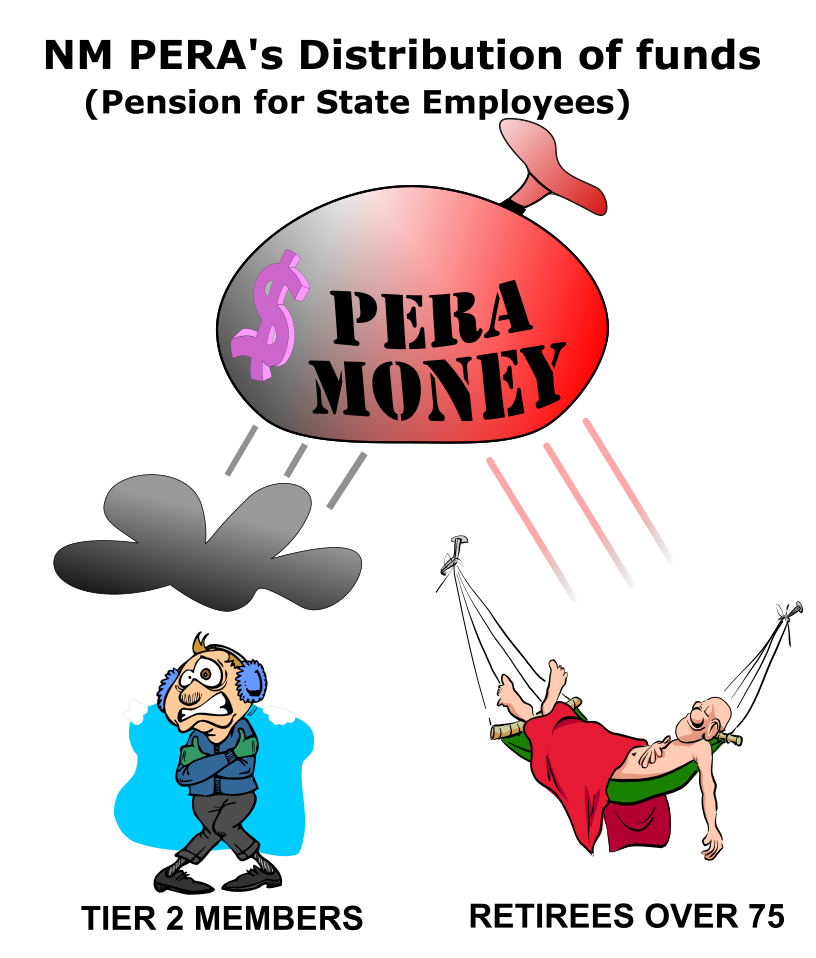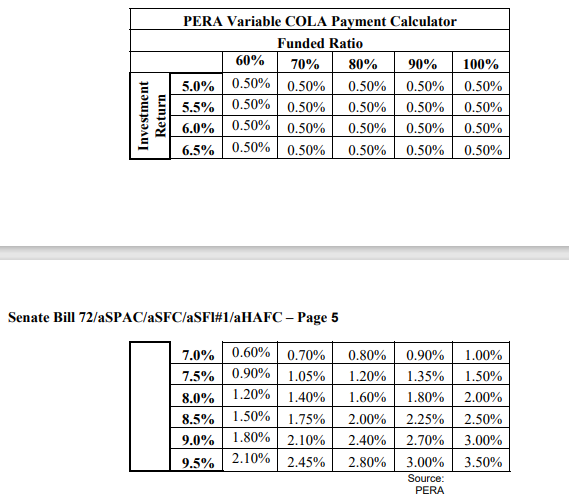This is an article that I am trying to get published in a newspaper or website. If you have any comments or suggestions, please leave them in the comment section on the Ponzi Scheme home page.

New Mexico State’s effort to make the Pension for State Employees solvent has resulted in different groups of retirees and employees. The Senate Bill 72 in 2020 has effectively created three member types:
- Retirees over 75 as of June 30, 2020 (28% of retirees fall into this class). Retirees are also Tier 1 Members.
- Tier 1 Members (employed before June 30, 2013)
- Tier 2 Members (employed after June 30, 2013)
Retirees over 75 years old have secured a sweetheart deal on their pension where Tier 2 Members pension benefits have been drastically reduced. The changes that the NM State Government made to the PERA Pension for state employees now resemble a Ponzi Scheme.
The changes to the Pension Plan:
Senate 72 Bill changes:
Pension Factor
For Retirees over 75 and Tier 1 Members, the pension factor is 3.0. The pension factor for Tier 2 Members is 2.5. The employee’s pension is based on the pension factor and Final Average Salary.
Example of how the pension factor and the final average salary are used to calculate pension:
(Years of Service Credit) X (Pension Factor) X (Final Average Salary) = Monthly Pension Benefit
Example: for a member retiring with 25 years of service credit with a final average monthly salary of $5,333.
For Retirees over 75 (and Tier 1 Member):
25 | X | 3% | X | $5,333 | = | $4,000 |
(years of service credit) |
| (Pension Factor) |
| (final average salary) |
| (monthly pension) |
For Tier 2 Member:
25 | X | 2.5% | X | $5,333 | = | $3,333 |
(years of service credit) |
| (Pension Factor) |
| (final average salary) |
| (monthly pension) |
2. Cost of Living Allowance (COLA)
Starting in 2020, Retirees over 75 started receiving a 2.5% COLA for life. In contrast, the COLA for all other retirees will be determined based on the plan’s Funded Ratio and Investment Returns. Below is the PERA Variable COLA Payment Calculator used to determine future COLA.

Based on PERA’s COLA Table, a Fund Ratio of 100% and an average investment return of 6.5%, the future COLA will be 0.5%. PERA’s average investment return for the last 5 years was 6.35%. For the last 3 years, the average investment return was 3.75%. With the investment return being an average return over several years, a COLA of 0.5% is a reasonable value for all future COLA.
The following table shows the differences between a Pension for Retirees over 75, Tier 1, and Tier 2 retirees. The Pension is based on a pension of $4,000 per month for Retiree over 75 and Tier 1. For Tier 2 retirees, a pension of $3,333 per month.
Year | Monthly Pension Retirees over 75 | COLA (2) | Monthly Pension Tier 1 | Monthly Pension Tier 2 | COLA Tier 1 and 2 |
2019 | $4,000 |
| $4,000 | $3,333 |
|
2020 | $4,100 | 2.5% | $4,000 | $3,333 | 0% (2) |
2021 | $4,203 | 2.5% | $4,000 | $3,333 | 0% (2) |
2022 | $4,308 | 2.5% | $4,000 | $3,333 | 0% (2) |
2023 | $4,415 | 2.5% | $4,020 | $3,350 | 0.5% (1) |
. .
| . .
| . .
| .
| . .
| . . |
2048 | $8,186 | 2.5% | $4,554 | $3,794 | 0.5% (1) |
2049 | $8,390 | 2.5% | $4,554 | $3,813 | 0.5% (1) |
Total | $2,208,013 |
| $1,582,777 | $1,318,849 |
|
( 1 ) COLA is based on PERA’s Variable COLA Payment Calculator and an average investment return of 6.5%.
( 2 ) 2020 Senate Bill 72 Retirees over 75 received a COLA of 2.5% for life, everyone else received a 0% COLA for years 2020, 2021 and 2022.
After 30 years, the monthly pension for Tier 2 Members is $3,813 which is less than half the pension of $8390 for Retirees over 75. Tier 1 Members pension is $4,554.
3. Retirement Age Requirement:
Retirees over 75 (and Tier 1 Members)
25 years of service could retire at any age.
Tier 2 Member
Any age if the sum of the member’s age and years of credited service equal at least 85 (Rule of 85 for retirement). For a member with 25 years of service would have to be age 60 to retire (25 years of service + age 60 = 85)
4. Final Average Salary
Retirees over 75 (and Tier 1 Members)
The final average salary is based on 36 consecutive months.
Tier 2 Members
The final average salary is based on 60 consecutive months.
5. Employee Pension Contribution
Tier 1 and 2 Current Employees
Senate Bill 72 increased employee contributions from 8.92% to 10.92%. Consequently, employees will experience a 2% reduction in their pay due to the increased pension contribution rate.
Summary:
The NM State’s attempt to make its Pension Fund solvent is not fair for all participants. Workers forgo higher wages in exchange for a promise of a future payment secured by trust property. The trust is supposed to be used to pay the same pension to all the beneficiaries. However, the State of New Mexico has created different classes of members, treating each class differently. The oldest retirees receive the best benefits, while current employees must pay more into the pension and receive the least benefits.
This raises concerns about fairness and the equitable distribution of pension benefits, as the State has created different classes of members and is treating them unequally. It seems the State of New Mexico is modeling its pension reforms after a Ponzi scheme.
I do not see any simple solution to make PERA solvent, but the State of NM needs to create two separate pensions: one for Tier 1 Members and one for Tier 2 Members. It is unconscionable to have Tier 2 Members responsible for the pension solvency by reducing their benefits and increasing the payroll pension deduction from 8.92% to 10.92%.
The State of NM also needs to reduce the COLA for retirees over 75 (as of June 30, 2020) to 0% until their pension payout is the same as the rest of the Tier 1 retirees.
Additional information can be found at www.nmponzi.com